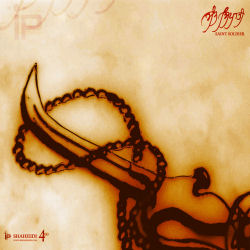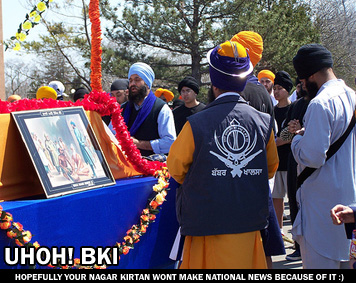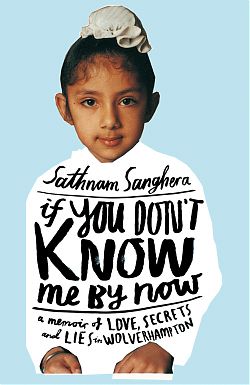
 So it’s wedding season for many Panjabis in the Diaspora and one key product commonly used across South Asian groups is batnaa (the yellow mixture used on a groom/bride a day before the wedding to clear up the complexion). Guess what? Jessica Alba is now on boxes of Batnaa! When I saw this I laughed and got confused … what is going on here? I find it interesting that Alba is on the box … maybe it’s because she “looks” more South Asian than say Hillary Duff? Any other ideas?
So it’s wedding season for many Panjabis in the Diaspora and one key product commonly used across South Asian groups is batnaa (the yellow mixture used on a groom/bride a day before the wedding to clear up the complexion). Guess what? Jessica Alba is now on boxes of Batnaa! When I saw this I laughed and got confused … what is going on here? I find it interesting that Alba is on the box … maybe it’s because she “looks” more South Asian than say Hillary Duff? Any other ideas?


Also, American stars are being used to market traditional South Asian products rather than relying on Bollywood stars. Anyone else out there seen something similar in marketing other traditional South Asian products?
Some of you may have followed the case of Sarika Singh, a Welsh-Sikh student who was barred from school when the organization adopted a dress code that prohibited wearing jewelry, including religious items. Instead of conforming to the dress code or transferring schools, Singh appealed to the school. When officials refused to reverse their decision or provide exception for the kara (not an item of jewelry, but rather an article of faith), Singh sued under the UK’s anti-discrimination laws. She has been excluded from classes and from attending school for the past nine months.
Moments ago, the BBC reported that the UK’s High Court affirmed her case, stating that the dress code unfairly burdened Singh’s freedom of religious expression. Both advocates and the court expressed frustration with the school, stating that the issue had been clearly defined in U.K. statutes and case law for over 20 years. This judgment opens the door for students of all religious backgrounds; in addition to the banning of the kara, other UK (private) schools have moved to ban the crucifix, the hijab, and the yarmulke. Against this “confining” interpretation of secularism (an interpretation more common on the European continent), the UK courts have clarified the intent of the country’s inclusionary and anti-discriminatory legal framework.
We’ll continue to update with details and analysis as information becomes available.
This recent article about a granthi in Leeds suing for unfair dismissal brought me back to the topic of granthis in general. Given Sikhi’s very clear edict AGAINST the institution of a clergy, I always found it distressing to see whole gurdwaras managed and oragnized by hired granthis. If a sangat (or gurdwara) was too big to function on seva, hadn’t it possibly grown beyond its equilibrium? I always felt uneasy about high-profile (and high cost!) guest granthis, specialized sermons, and other performance-based methods in the gurdwara. Not to mention really distressed that lecturing and sermonizing often extended services and, in my opinion, often drew away from time spent in reflection around kirtan.
It also seems, to me, that the formal establishment (and acceptance) of granthis as “ordained” disciples of Sikhi encourages the creation of a laity. In theory, shouldn’t all Sikhs be capable of organizing and leading their own services? Shouldn’t we encourage everyone to achieve the literacy and familiarity necessary to comfortably participate in shabad kirtan, ardaas, and the basic requirements of langar? In the U.S., we absolutely do not provide sufficient resources to ensure this across sangats (some sangats are notable exceptions, e.g., the Beavercreek, OH, sangat, which is completely volunteer-run with no granthis, despite a population of <50 Sikhs). If we wanted to help mobilize Sikhs to be able to run their own gurdwaras, what kind of resources would we need to provide?
I understand that once we employ granthis there’s an implicit contract and deferral to their “wisdom,” but to what extent are we eroding our own personal understanding and potential for discussion, debate, and growth within Sikhi and within our own sangats? I have heard some liken granthis to spiritual guides; I would argue, however, that SGGS Ji is our guide, the Rehit Maryada our manual, and the sangat our laboratory for refining our understanding.
The UK has been hit with a recent controversy over expenditures, allegedly upwards of £100,000, spent on finding appropriate anti-terror gear that could accommodate the Sikh turban. A good deal of this was spent taking the officer away from duty and asking him to approach equipment manufacturers himself to request accommodated gear. Shortly after this search period expired, he took a leave in order to cope with the emotional stress of this experience.
Two very salient arguments are made: One side argues that such cost was a “waste” and took the officer in training away from assignment (he was in limbo — he was not able to serve with the regular police, but without a uniform could not get full clearance to serve with anti-terror specialists). The other argues that the officer is sorely needed, that the county he hails from is actively trying to diversify its anti-terror police force, and that the cost is worth it if it paves the way for other ethnic and religious minorities to feel comfortable trying out to join the anti-terror squadron.
I think there’s validity to both arguments. Accommodation, especially in democracies, ought to be a key value in integrating diverse communities. That said, it sounds like the UK (or local) government did not take the issue of diversity seriously. The problem is not in the £100,000, per se, it’s in the failure of the state to actively support, or deal seriously with, the issue of Sikh guards.
But is there ever a (monetary) limit to accommodation? How do we find that limit? Is it a simple cost-benefit analysis, or are there other, more weighted, measures that come into play? Was it the money itself, or the poor management of said money?
 72 year old Balwant (“Bobby“) Singh Grewal is walking 500 miles (800 km) from the Scottish Parliament Building in Edinburgh to the House of Parliament in London in five weeks. He began on June 5th and is scheduled to finish on July 9th. He is raising 100 million pounds for cancer research. (If you can’t tell by the bolded format, I’m rather impressed by this feat.)
72 year old Balwant (“Bobby“) Singh Grewal is walking 500 miles (800 km) from the Scottish Parliament Building in Edinburgh to the House of Parliament in London in five weeks. He began on June 5th and is scheduled to finish on July 9th. He is raising 100 million pounds for cancer research. (If you can’t tell by the bolded format, I’m rather impressed by this feat.)
Grewal is undertaking the walk to raise one million pounds for research into bowel cancer and other bowel diseases at St Mark’s Hospital, Harrow, a hospital unique in the U.K. [link]
This isn’t the first time Bobby Grewal has walked to raise large sums of money for medical research.
In 2001, he ran the London Marathon in just over five hours, and in 2004-5 (aged 68), he completed a walk covering 2,500 miles across India from the North-West frontier to the deep South…The walk raised 100,000 pounds for research into cancer and AIDS. [link]
Do you think Bobby Grewal is in the same class as the legendary Fauja Singh?
In a day of updates, I figured I should update this one as well.
Although losing out on the 100,000 pound grand prize, the dynamic duo of Suleman Mirza and Madhu Singh have been invited by Michael Jackson to join him on his comeback tour in the UK. The newspaper report is a bit ambiguous suggesting that Signature may also perform with MJ in Las Vegas as well. Amazing job fellas! I am sure they are on cloud 9.
—————————————————————
We’ve been following Signature over the last few months. From their audition appearance, to their semi-final Thriller, to even an interview with me highlighting their place in British Bhangra, before we all suffer from Signature overkill here is Suleman Mirza (often misspelled as Suleiman ) and Madhu Singh’s final performance.
Our dynamic Muslim and Sikh duo finished second on Britain’s Got Talent (BGT) to the dancing talent of George Sampson. While I was hoping for a “Beat It” performance, Madhu’s busy work schedule at PC World may not have allowed him to come up with a new routine. They stuck to their bread and butter of Tigerstyle’s Nachna Onda Nahin. A fine performance fellas. You even got Simon Cowell and the rest of the dorky judges to dance in their chairs.

So we have seen two (here and here) performances by Signature. Although most Langar-ites did not seem to enjoy the second performance as much, it impressed enough people to propel the duo into the finals of Britain’s Got Talent. In fact they were the first team to be voted in by the public.
Now, in their first interview, Suleman (often incorrectly spelled Suleiman ) Mirza and Madhu Singh shed some light and perspective on their performance:
“Our routine is about togetherness and overcoming conflict,” said the rather handsome Mirza, who has been a Jackson fan since he was six years old. “I start the act with a Western dance, and then Madhu comes on stage. I look down on him because I don’t understand his culture. But he surprises me, and he works really hard, symbolising immigration, and then we work together, and show that everyone can get on.”[link]
Heavy stuff, but I’ll buy it.
I may be stealing Anandica‘s UK thunder, but I couldn’t resist.
A month ago, we were introduced to Signature, a phenomenal dance act by a Muslim, Suleman (too often misspelled as Suleiman) Mirza and his Sikh partner, Madhu Singh on Britain’s Got Talent.
However a big question remained. After their brilliant previous performance, Simon Cowell (better known to us Yankees as Simon of American Idol fame) asked, “Now that we know what the surprise is, what do you do in the next round?” Suleman answered, “We keep on surprising you.”

Anyone want to put money for their finals presentation: “Beat It“, “Bad” (although I always liked Weird Al’s Fat better), or “Smooth Criminal.” Any other possibilities?
My vote is for “Beat It.” I just think it would fit their format much better, plus Madhu would look great in that white ‘gangsta’ bomber jacket. Suleman would HAVE to wear that red zipper leather (or pleather) jacket. I can’t lie, I had one back in the day. It might not fit, but that might make it even work better. I am sure I could dig through the old stuff and let Suleman borrow mine. The knife scene between the two would be classic. Hopefully they can get in touch with Tigerstyle to do a mix for them. So Madhu and Suleman, here is your first vote! What about the rest of you?
Usually on Friday, I like to post something musical, something funny, or even something just plain stupid. However, when I saw this news article, I was just so incensed. Yesterday I commented in another discussion that Sikhs need to begin to confront our own Muslimophobia. Another pervasive demon is our prejudice against those of African descent (and yes, dark skin in general).
Apparently at a cricket match at the Mohali Stadium, two black British cheerleaders were asked not to participate by an organizer due to their skin color. The women even allege that the organizer used the ‘n-word.’
Newton told a newspaper: “An organiser pulled us away. He said the people here don’t want to see dark people. The ‘N’ word was used and they said they only wanted beautiful white girls. We were crying. I could understand if it were the crowd, but they were very receptive.”[link]

Going along with the theme of music which has been popping up all over TLH recently, I came across a documentary from the Asian Network discussing (what the presenter calls) the arrival of a new music scene in which religion is playing a large role in the work of British Asian artists. Now, “religious” music in this innovative sense may not be new to those of us who have been exposed to this type of music before, however as the documentary suggests, religion-focused music is becoming more mainstream and accepted (which, as will be discussed, can be a both positive and negative thing). There still exists the contradictory acceptance of religious music, however, with music promoting Sikh, Hindu, or Muslim values being viewed as conventional and any type of Christian pop/rock music seen as too radical. The question asked throughout the documentary is why is religious music “cool” for British Asians?
 The argument is that an increasing number of youth are not attending Gurdwaras (or Mosques or Temples) and this type of music is much more accessible to this generation because of the medium in which the message is disseminated. Outlandish and Tigerstyle, two groups discussed in the documentary as promoting religious and political values through their music, are making music which is “real and more conscious” and by doing so, keeping the teachings of the religion alive. While we’re all familiar with Tigerstyle, Outlandish is a hip-hop group based in Denmark whose music includes themes about Islam and contemporary issues facing young Muslims in the west. For too long now, music within the Indian community has been lacking substance. While mixing religion with music is a challenge in secular communities in which these artists exist, there is an obvious desire for it too.
The argument is that an increasing number of youth are not attending Gurdwaras (or Mosques or Temples) and this type of music is much more accessible to this generation because of the medium in which the message is disseminated. Outlandish and Tigerstyle, two groups discussed in the documentary as promoting religious and political values through their music, are making music which is “real and more conscious” and by doing so, keeping the teachings of the religion alive. While we’re all familiar with Tigerstyle, Outlandish is a hip-hop group based in Denmark whose music includes themes about Islam and contemporary issues facing young Muslims in the west. For too long now, music within the Indian community has been lacking substance. While mixing religion with music is a challenge in secular communities in which these artists exist, there is an obvious desire for it too.
On the other hand, the documentary asks whether this type of music is further segregating British (or American or Canadian) Asians? The post 9/11 British Asian identity has largely been disintegrated into a British Sikh, British Muslim, and British Hindu identity. Is promoting religion-specific music going to augment this segregation? Are these artists such as Tigerstyle and Outlandish isolating listeners who may not be Sikh or Muslim? Or is this type of music somehow uniting us? Nusrat Fateh Ali Khan, for example, used Sufi music to cross boundaries amongst religious lines. His music is seen as uplifting and inspiring to people of all religions.
Skimming the other Sikh blogs, I found this post (on a great blog that I am starting to like and not just because he is also an Immortal Technique fan) about a Sikh conscious rapper from Toronto. Although I couldn’t find too much on the internet about Kanwer Singh, other than the fact he is a recent college graduate, the comments on his works have received much praise on youtube. Kanwar goes by Humble the Poet (maybe an allusion to Bhat Bani? SGGS 1400). I personally found this track amazing. (Don’t worry Joolz/Bobby/Suzy, no bad language here)
The track deals with a number of incidents that have plagued the Punjabi Sikh community in Toronto, Canada (although unfortunately Kitimat is there too). However these problems are hardly limited to Canada. They are the stories of our diaspora. From male youth violence, AIDS, domestic violence, alcohol abuse, and drug abuse, this song hits on it all. In fact many of these are themes that get talked about at the Sikh conference I mentioned yesterday. In case you were interested, you can download Kanwer’s track here.
Looks like I have another favorite Sikh rapper along with Mandeep Sethi from the Bay. Your thoughts?

I came across this video, linked from PP about the elections for the mayor of London. For more election coverage, visit Pickled Politics. Check out this video on ‘how to campaign’ in Southall. The desi van is just classic. It is almost exactly as they campaign in Punjab. I wonder if they distribute free alcohol and drugs like Badal’s Akali Dal and the Congress.

I thought I had seen something similar in a movie before. Here it is….forward to 3:10

So yesterday (4/23/08) for all of our valeti readers was Saint George’s Day. For the rest of us that probably don’t care (including apparently most of England), Saint George is the patron saint of England (sort of like Saint Patrick for the Irish) that:
care (including apparently most of England), Saint George is the patron saint of England (sort of like Saint Patrick for the Irish) that:
[Saint George] was a third-century Turkish soldier who supposedly had the power to slay a dragon but likely never set foot in Britain. [link]
Since he was probably Turkish to begin with, it seems like there should be no problem that Chaz Singh should be the Modern Day Saint George.
Modern Day St. George –> click here to watch BBC Video (love the British teeth!)
Chaz Singh is no newcomer to the media spotlight. He has been highlighted in a traveling picture exhibition as well as been commented upon by some popular desi blogs:
Chaz Singh is one of the recipients of the BBC Breeze bursaries that has enabled him to develop his ideas about identity in a series of photographic images and poems. [link]
Is Chaz SIngh trying too hard? Probably, but that he should even be accepted as such should be seen as a move towards cultural pluralism. Chaz Singh is attempting to make the turban very much English. No different than custard and roastbeef.
In an interesting twist an Indian Bihari family is claiming that the 9-years-old Gurrinder is really their kidnapped son 6-years-old Shintu Kumar, who was kidnapped on March 3rd of this year.
really their kidnapped son 6-years-old Shintu Kumar, who was kidnapped on March 3rd of this year.
The mother has stated:
“We saw his photo too [on TV]… I know my child.”
The Bihari police have stated that a DNA test will need to be conducted before proceeding further. The family was able to move immediately as the mother is related to a prominent Bihari legislator. Officials in England have been notified. Our thoughts are with the child and hope that he is being taken care of and that he may be reunited with his proper family soon. More as it become available….
—————————————————————————————
Although there may be more pressing global news, especially as the morning newspapers report about the 4,000th death of an American soldier, along with the soon approaching 90,000 projected Iraqi civilian deaths, in the last six years in Iraq, I start the week with a question that is being asked by the Sikh community in Southall (London, UK). Who is this child?
Recently on “The Langar Hall” there has been discussion about “Runaway Grooms” who with their immigration status abroad marry women from Punjab, only to abandon them after receiving the dowry. Along with being deserted by their husbands, these women’s “dreams” of going abroad are also shattered. These “dreams” were generally a primary reason many of the women were married to these men. Hasit Shah writes in his BBC news article,
“You can see it around you. There is a lot of foreign money in this city [Jalandhar]. The NRIs have been coming back and building huge houses and flaunting their success. The locals see this and want a better life for their daughters, but when the husband is unscrupulous, the women’s lives are ruined.”
Many Punjabi men in Punjab/India are also tremendously influenced by this wealth and have dreams of going abroad (a lot of it has to do with lack of job/economic opportunities in Punjab). NRI women’s green cards and citizenship status become routes for gaining permanent residency abroad. Interestingly, it is the “unscrupulousness” behavior of “husbands” and gendered power dynamics prevalent in “Runaway Groom” situations that translate into the predicaments faced by a growing number of NRI women who are also manipulated and abused by their Punjabi Sikh husbands from Punjab/India. Their “husbands” were not interested in a marriage … they really only wanted the money and permanent residency abroad. I completely agree that this is not the outcome of all NRI and non-NRI marriages. Many couples are very happy. Yes, I acknowledge that the circumstances are different for NRI and non-NRI women based on the power hierarchy between the
Last week, an article appeared in the Toronto Star by a young university student, Jasmeet Sidhu. In the article Jasmeet discusses her [is this gender assumptions or what, the name given is only Jasmeet Sidhu and nowhere in the article does it state whether she is male or female, but I am assuming female based on her music tastes] problems with living the life of a “bicultural suburban teen.” Now this topic is hardly new to the The Langar Hall. In fact in some ways, it has been discussed here in various manifestations many many many times.
problems with living the life of a “bicultural suburban teen.” Now this topic is hardly new to the The Langar Hall. In fact in some ways, it has been discussed here in various manifestations many many many times.
Jasmeet’s case seems to follow a similar story. Tired of the what she feels is the hypocrisy of her own community, she is attracted by the lures of greater Canadian society. [An interesting assumption here is that Punjabi-Canadian society can never be considered ‘Canadian’ despite the huge presence, influence, and cross-cultural encounters that have spanned for more than a century.]
For Jasmeet and for many others, the world seems only binaries:
Bhangra or Rihanna? Arranged or “love” marriages?
The Broadcast Piece:
Last week Radio 4 on the BBC broadcasted a piece titled “Sikh Terror – the UK Connection.” The piece was produced by Amardeep Bassey as an investigation into possible terror links within the UK Sikh community. You can download the 40 minute report by clicking here.
 Despite other bloggers believing that criticism of the piece by Bassey somehow emboldens the enemies, my feeling is that is as stupid as saying “You’re with us or with the terrorists.” However, those that cannot begin the process of internal discussion within the community are guilty of the same stupidity.
Despite other bloggers believing that criticism of the piece by Bassey somehow emboldens the enemies, my feeling is that is as stupid as saying “You’re with us or with the terrorists.” However, those that cannot begin the process of internal discussion within the community are guilty of the same stupidity.
I have major problem’s with Bassey’s portrayal. To interview Ajay Sahni and claim him from the “independent Institute of Conflict Management in New Delhi,” the same organization that is headed by the “Butcher of Punjab” – KP Gill, flies in the face of all Sikhs. The praise that Gill receives in the Indian press and this omission in the BBC report only further insults those families that were devastated by state violence. Human rights groups such as the Khalra Action Committee, ENSAAF, and others are at the forefront of fighting for justice for the victims of state violence. To interview a member of an organization that is led by Gill, claim him as an ‘independent’ authority, and not provide context about the charges raised by groups such as Amnesty International and Human Rights Watch about Gill is beyond an error of omission. It reeks of negligent white-washing.
Recently, I watched a brilliant documentary called The Power of Nightmares: The Rise of Politics of Fear. Produced by the BBC, this documentary is 3 one-hour films comparing the rise of the American Neo-Con movement with the radical Islamists. It discusses certain parallel ideologies and the symbiotic relationship of the two that serves only to create fear and terror.

So before you head out to watch Will Ferrell’s Semi-Pro, this movie deserves your time. Maybe less laughs, but I found it absolutely fascinating.
Although I saw it in a theatre, Youtube has the beginning clip and the entire movie can be streamed here.
Your thoughts?
When an author chooses to write a memoir, they take the risk of unveiling a plethora of secrets that otherwise (and perhaps preferably) would remain buried. And when that author is Punjabi Sikh, it is almost guaranteed that issues will be brought up that make people uncomfortable.  For our parents’ generation, secrets remain in the family and they are never discussed in public – we are raised to uphold the family izzat (honor). But at what cost do we remain quiet? A new memoir by Sathnam Sanghera, If You Don’t Know Me By Now: A Memoir of Love, Secrets and Lies in Wolverhamptom, opens up the dialogue around being raised in a working-class Punjabi immigrant family and being a child living in a family paralyzed by schizophrenia. Some of these experiences can be felt universally throughout the Panjabi community and others are more personal, but what is clear is that there is a great need in our community to dialogue about these issues.
For our parents’ generation, secrets remain in the family and they are never discussed in public – we are raised to uphold the family izzat (honor). But at what cost do we remain quiet? A new memoir by Sathnam Sanghera, If You Don’t Know Me By Now: A Memoir of Love, Secrets and Lies in Wolverhamptom, opens up the dialogue around being raised in a working-class Punjabi immigrant family and being a child living in a family paralyzed by schizophrenia. Some of these experiences can be felt universally throughout the Panjabi community and others are more personal, but what is clear is that there is a great need in our community to dialogue about these issues.
I clutched my schoolbag tightly as I walked along with Dad, as if my life and dignity depended on its contents (which, in a way, they did), mumbled the Japji Sahib, the beginning of the Guru Granth Sahib Mum had taught me, and watched Dad hum to himself – Hindi songs I didn’t recognise from Bollywood films I’d never seen – click his fingers to some beat I couldn’t hear, and smile, at people going past, at nothing in particular. [Link]
While I haven’t yet read the memoir (it is being released in March), several articles discuss his story at length. It wasn’t until he was in his twenties that Sanghera realized his father was a paranoid schizophrenic and his older sister also shared the condition. Intermingled within that tale is Sanghera’s own story of being a young Sikh boy growing up in Wolverhampton (one of the most densely populated Sikh communities in the UK).
Earlier this week I blogged about how Queer/LGBT Sikhs have been (shamefully) excluded from the Sikh community by religious leaders. Today, I was sent the following blog post and BBC article about “marriages of convenience” for queer desis who feel they cannot come out, by virtue of their religious or ethnic identities (thanks, Jodha!). Balbir Singh, a leader in the Southall community comments:
“The whole family suffers. We are living in 2008 and it’s time they should come out to the parents… I’ve even heard that parents have died because of the shock of finding out about these pretend marriages. But for Asian gays and lesbians, the situation is very difficult.”
